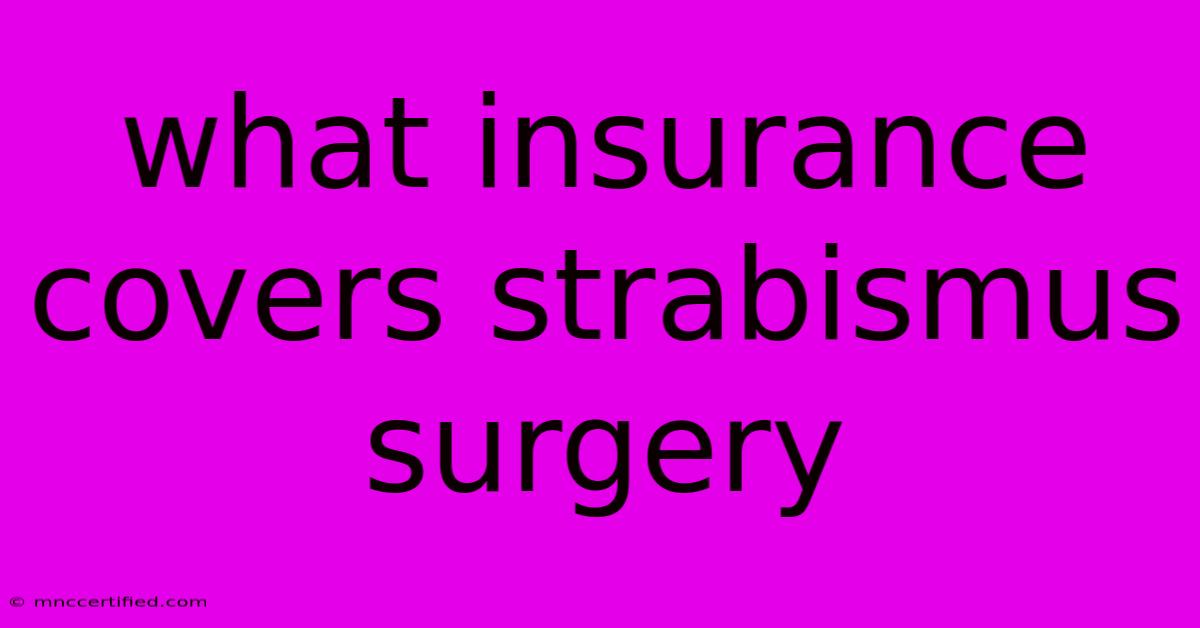What Insurance Covers Strabismus Surgery

Table of Contents
What Insurance Covers Strabismus Surgery: A Comprehensive Guide
Strabismus, commonly known as crossed eyes, is a condition where the eyes don't align properly. This can cause a variety of issues, including double vision, headaches, and difficulty with depth perception. While some cases of strabismus can be managed with glasses or eye exercises, surgery is often necessary to correct the alignment and improve vision.
But what does insurance cover when it comes to strabismus surgery? The answer can vary depending on your specific insurance plan, state laws, and the type of surgery needed. Here's a breakdown of what you need to know:
What Insurance Typically Covers
Most insurance plans cover medically necessary strabismus surgery for children and adults. This means the procedure must be deemed essential for improving vision and addressing a medical issue. Here are some key aspects generally covered:
- Diagnostic testing: This includes initial consultations, eye exams, and tests to determine the cause and severity of strabismus.
- Pre-operative care: This may include medications, pre-surgery appointments, and any necessary adjustments to glasses or contact lenses.
- Surgery itself: This includes the surgical procedure to realign the eye muscles.
- Post-operative care: This includes follow-up appointments, medications, and therapy to help with recovery.
Factors Affecting Coverage
While strabismus surgery is often covered, several factors can influence whether your insurance will pay for the procedure:
- Type of insurance: Some plans, like Medicare, may have specific guidelines for strabismus surgery coverage.
- Pre-existing conditions: If you have other eye conditions or medical issues, your insurance may require additional information or documentation.
- Age: Some plans may have different coverage for children versus adults.
- Procedure complexity: More complex strabismus surgeries might require pre-authorization or specific documentation.
What's Not Typically Covered
While most insurance plans cover the basics, some expenses related to strabismus surgery might not be included:
- Cosmetic procedures: If the surgery is solely for cosmetic reasons, your insurance likely won't cover it.
- Out-of-network providers: Choosing a surgeon not within your insurance network can significantly impact your out-of-pocket costs.
- Non-essential treatments: Treatments considered unnecessary by your insurance company, like specific types of therapy or non-surgical options, may not be covered.
Understanding Your Coverage
The best way to determine what your insurance covers is to contact your insurance provider directly. They can provide you with a detailed breakdown of your plan's benefits and any limitations.
Here are some tips:
- Check your policy documents: Your insurance policy will outline your coverage for surgical procedures.
- Ask for a pre-authorization: Even if your policy appears to cover the surgery, it's best to get pre-authorization from your insurance company before scheduling the procedure.
- Seek clarification on out-of-pocket expenses: Ask about your co-pays, deductibles, and any limitations related to the surgery.
Additional Considerations
- Second opinions: Consider getting a second opinion from another ophthalmologist specializing in strabismus. This can ensure the surgery is truly necessary and help you understand different treatment options.
- Financial assistance programs: If your insurance doesn't cover all the costs, inquire about financial assistance programs offered by hospitals or charitable organizations.
By understanding your insurance coverage, you can make informed decisions about your strabismus treatment and navigate the costs associated with this procedure. Remember, open communication with your doctor and insurance provider is key to achieving the best possible outcome for your eye health.

Thank you for visiting our website wich cover about What Insurance Covers Strabismus Surgery. We hope the information provided has been useful to you. Feel free to contact us if you have any questions or need further assistance. See you next time and dont miss to bookmark.
Featured Posts
-
Septa Strike Philly Schools May Go Virtual
Nov 08, 2024
-
How To Become An Insurance Agent In Ohio
Nov 08, 2024
-
Evan Williams Bottled In Bond Mash Bill
Nov 08, 2024
-
Powell Stands Firm No Fed Resignation
Nov 08, 2024
-
Northbrook Insurance Claims Phone Number
Nov 08, 2024